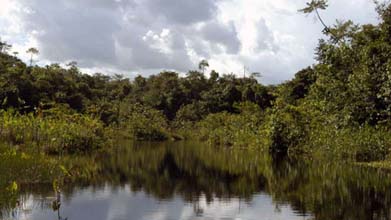
A study by the University of Valencia, recently published in Journal of Geophysical Research, announces that the Amazonian forest resilience to heat stress may be weakening, with the risk of acceleration of global warming. The study, which comes to this conclusion after evaluating the effects of the droughts of 2005 and 2010 in the tropical forests of the Amazon, comes from the Global Change Unit of Image Processing Laboratory (LPI) in the University of Valencia' science and technology park.
The Amazon represents around 50% of the world's tropical forests. They constitute a key component of the global carbon cycle, so that the changes that occur in these forests can affect the concentration of CO2 in the atmosphere and thus climate change itself.
One of the most important factors of climate change on the Amazon are severe droughts, phenomena produced by an increase in sea temperature, particularly in the eastern Pacific Ocean, and popularly known as El Niño.
However, over the last decade, in 2005 and 2010 - there have been two extreme droughts and anomalous - the largest in the last century, which are not associated with an increase in sea temperatures in the Pacific Ocean, but to an increase in sea temperatures in the Atlantic Ocean.
Numerous studies have analyzed in recent years the effect of drought on the "greenness" of the Amazon forest measured with satellite data, but few studies have analyzed the role of thermal anomalies
Global Change Unit belonging to the Image Processing Laboratory (IPL) has just completed a study of the temperature anomalies of the Amazon forests in recent decades, using climate data (from 1980-2012) and satellite data (from 2000-2012). The study was conducted by researchers Juan Carlos Jiménez-Muñoz and José Antonio Sobrino, both from the University of Valencia, with the help of Cristian Mattar (Universidad de Chile) and Yadvinder Malhi (University of Oxford).
The study analyzes the temperature anomalies in 2005 and 2010 (when extreme droughts occurred) and see if there were other years with anomalous warming, also examining which regions of the Amazon suffered further warming and the influence of sea temperature on this heating.
Los resultados muestran, sorprendentemente, que las anomalías térmicas positivas (calentamiento) no se produjeron únicamente en los años de sequía 2005 y 2010, sino que prácticamente se mantuvieron hasta el mismo 2012.
The results show that, surprisingly, positive thermal anomalies (heating) did not occur only in drought years 2005 and 2010, but practically they remained until 2012.
The most affected regions by the recent warming are in the Southeast, coinciding with the so-called "arc of deforestation", which includes the Brazilian regions of Rondonia, Mato Grosso and Pará, where deforestation practices have been more aggressive in recent years
It also notes that the anomalous warming is related to thermal irregularities of the sea temperature, both in the eastern Pacific Ocean and the tropical zone of the Atlantic Ocean, the latter being the most influential region has had in the last years, in which there haven't been severe El Niño events.
While it has always been considered that the Amazon rainforest have outstanding resistance to water stress conditions (as for example during a drought), the results shown in this study, along with other studies in which there has been a loss of biomass and even a temporary stop of the forest as a carbon sink during the droughts of 2005 and 2010, suggest that the Amazonian forest resistence to heat stress may be weakening.
Sustained warming in recent years, along with the predictions of some climate models of a higher frequency of severe droughts and even a change of tropical forest to savannah, represent a risk for the acceleration of global warming, although it requires a more analysis in the coming years in order to see if this recent warming remains or is a transitory phenomenon.
Article data:
“Spatial and temporal patterns of the recent warming of the Amazon forest”
Juan C. Jiménez-Muñoz, José A. Sobrino, Cristian Mattar, Yadvinder Malhi
Journal of Geophysical Research: Atmospheres, vol. 118, 5204-5215, 2013.
http://onlinelibrary.wiley.com/doi/10.1002/jgrd.50456/abstract
Last update: 7 de august de 2013 09:05.
News release



















